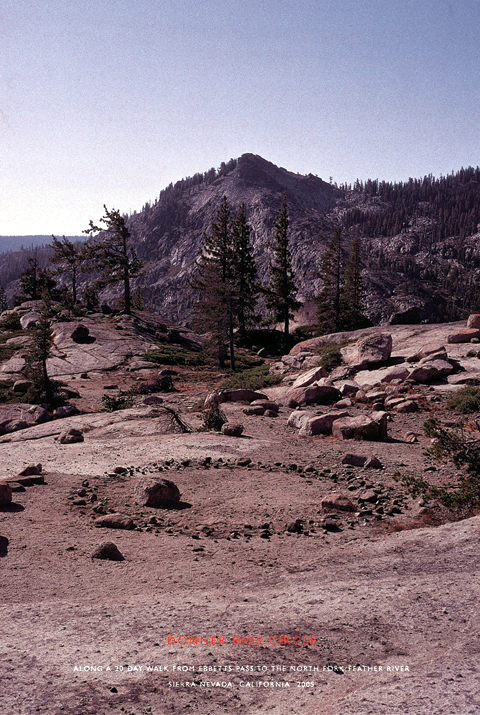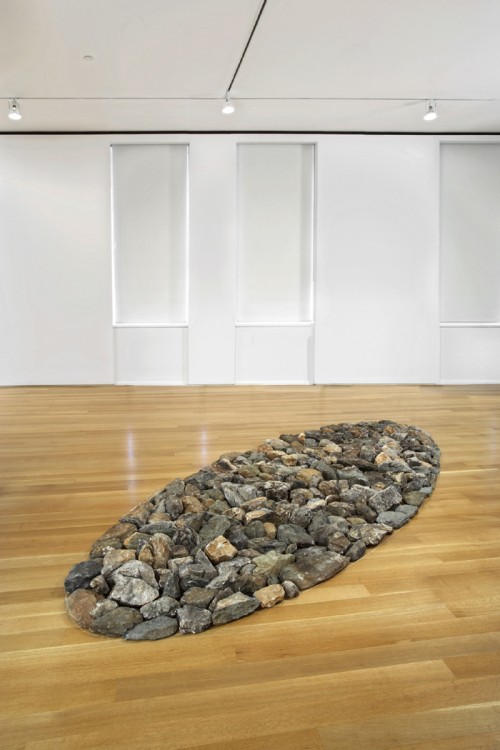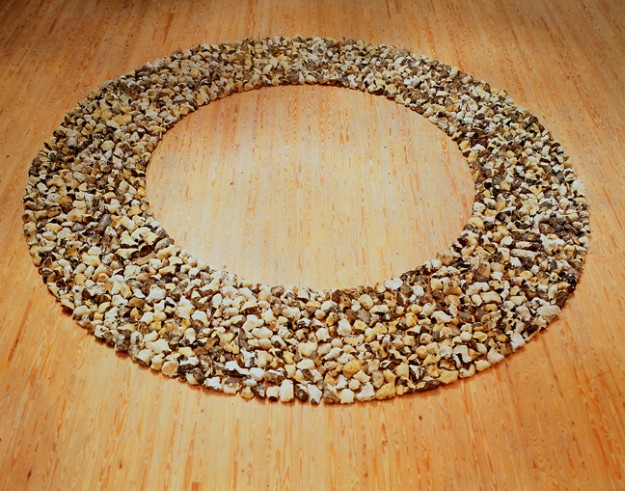
Richard Long From Water to Water, 2006 white mud, black paint and vinyl text on wall 130 x 469 inches 330.2 x 1191.3 cm

Richard Long From Enclosure to Circle, 2005 chromogenic print, unique 42 x 54 inches 106.7 x 137.2 cm

Richard Long Clover Lake Camp Stones, 2005 chromogenic print, unique 42 x 54 inches 106.7 x 137.2 cm

Richard Long Pacific Crest Trail Stones, 2005 chromogenic print, unique 42 x 54 inches 106.7 x 137.2 cm

Richard Long Red Mud Circle, 1994 terracotta clay and black acrylic paint on wall 148 inches diameter 3.7 m

Richard Long County Cork, Ireland, 1967 black and white photograph 30 5/8 x 40 7/8 inches 77.8 x 103.8 cm
Selected Interview:
The AI Interview: Richard Long
Artinfo.com, 5 July 2006
5 July 2006, by Robert Ayres
Artinfo.com, 5 July 2006
5 July 2006, by Robert Ayres
Richard, let me begin by asking you about your current show. One of the works is a photo and text piece titled This global warming seems to be doing us some good—A Dry Seven Day Coast to Coast Walk across Ireland, Winter 2006. That title rather surprised me. It almost sounds like a joke.
It’s just something slightly ironic that somebody said to me while I was on the walk, as a comment on the nice weather. The other panel of that piece says The land here is very bad, which was also a comment made to me by a farmer that I happened to be passing. It’s a very common expression that the locals use, because on the one hand, it’s idyllically beautiful there, it’s stunning scenery, but from the point of view of a farmer, his cattle haven’t anything to eat.
The reason I asked you about This global warming seems to be doing us some good was because I’ve never really thought of your work as having a sense of humor.
It’s not the primary purpose of my work, obviously. But if you pay attention over the years, a little wit creeps in, as do references to music. It just depends how well you know the work. There are subtle nuances in many of the text works.
The other thing I wanted to ask you about was how your work has been understood so differently over the years. When you first appeared on the scene in the late ’60s, you were seen as an irreverent revolutionary who seemed to want to turn sculpture on its head …
Yes.
… whereas now you’re seen very much as part of longstanding romantic landscape tradition.
Well, I might quibble about the use of the word “romantic,” but certainly a landscape tradition, absolutely, yes. But perceptions are bound to change over the course of 30 or 40 years, aren’t they? One can’t have the same position in the art world. I have a different view of my own work now than I did when I was a young artist. There’s more of it, for a start, and the cumulative effect of it also changes the perception.
Of course, a young man whom no one knows walking a line over a meadow [A line made by walking, England, 1967] is perceived very differently to an artist with a huge body of work behind him.
Sure, yes. And I would argue that the fact that I’ve continued to walk straight lines in many different geographical locations in all parts of the world, for different reasons, and for different lengths of time, enriches and changes the resonance of that very first line. If I’d just left it at that effort, and never walked a line again in my life, the significance of A line made by walking would be quite different now.
During the late ’60s and early ’70s, you were imagined to be part of a land-art movement.
That’s another thing that’s changed. It was only because I was in a few shows with the American land artists. You could equally see my work in relationship to arte povera, for example. Obviously I am of my time, and I would say that my work is a synthesis of certain aspects of conceptual art, minimal art and maybe arte povera.
Unlike some of your contemporaries, your work from that period doesn’t look like a relic from a distant time. And I think that’s because you haven’t made all sorts of different art since then—unlike someone such as Dennis Oppenheim, for example, who was imagined to be part of the same movement.
Yes, he’s been all over the place, hasn’t he? All I would say is that consistency and following a line of thought counts for something.
Consistency—like your use of the circle motif, which you’ve clearly found very sustaining throughout your career.
Exactly. It’s a powerful, strong idea that, as you say, has lasted throughout my career in different ways. In a way, time tests ideas, and if it’s a weak idea, it doesn’t pass the test of time, but if it’s a strong idea, then it does. That’s partly what all art’s about, isn’t it?
Finally, Richard, can you describe how you go about making work these days? I presume you’re approached all the time with commissions.
Yes. I resist many of them, because that’s not my preferred way of working. The works that I love to do most of all are just the walks in wilderness areas and making sculptures in the landscape in remote places. But my work has so many parallel threads: You mentioned circles, but you could talk about water, you could talk about stones, you could talk about time, you could talk about the big mud works that I make directly on the wall in galleries and museums, you could talk about my fingerprint drawings, you could talk about my mud works where I dip the paper in muddy water … there are many parallel but interrelated themes in my work.
So your preferred way to begin working is to identify a place?
A landscape. At the heart of my work is the fact that I make it myself. I have the pleasure of walking and being in these places and making these works in the landscape. It’s also a question of realizing particular ideas, too. So let’s say I have a certain idea about the symmetry of time and places, I can actually carry it out personally by walking that idea. In other words, there’s no point in getting somebody else to do it. The point of my work is my own physical engagement with the world in different ways, whether it’s walking, or making fingerprints, or throwing stones, or whatever.
(end)
Interview Source:
Image Source:
THANKS TO - https://farticulate.wordpress.com/















